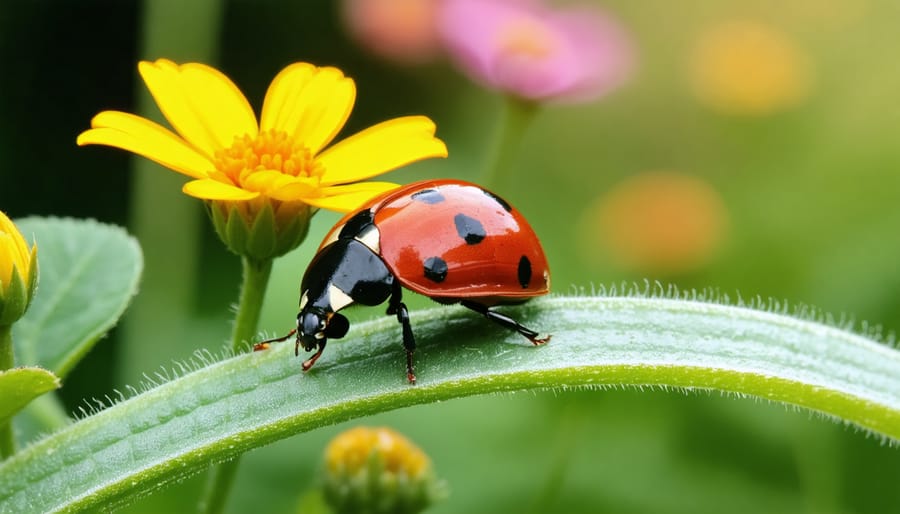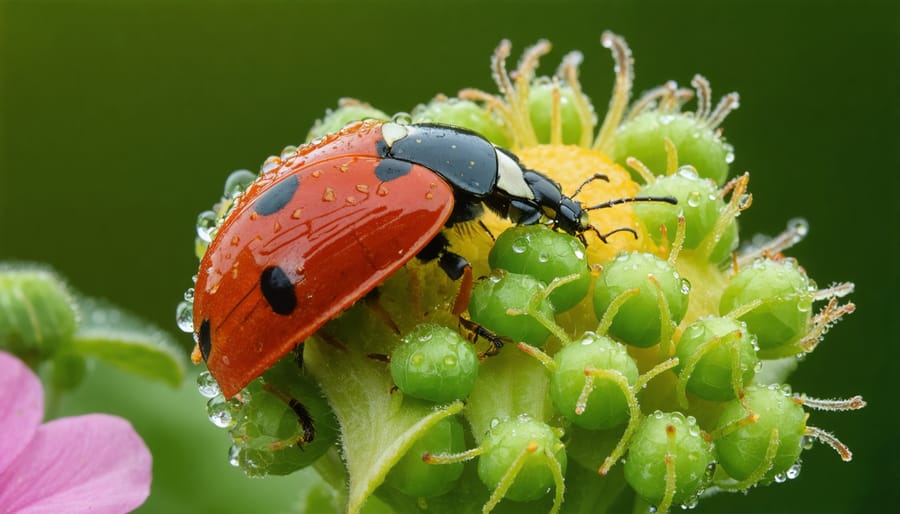Transform your garden into a thriving ecosystem by implementing an integrated pest management system that works with nature, not against it. Release beneficial predatory insects like ladybugs and lacewings early in the growing season to establish natural pest control. Plant diverse flowering species, including dill, yarrow, and calendula, to create habitat corridors that attract and sustain helpful insects. Monitor plant health weekly using yellow sticky traps and visual inspection to catch pest problems before they escalate. Establish healthy soil biology through regular compost applications and minimal tillage to strengthen plants’ natural defense mechanisms. This holistic approach eliminates the need for harsh pesticides while fostering a balanced garden ecosystem where beneficial insects thrive and problem pests remain naturally controlled.
Understanding Beneficial Insects in Your Garden
Predatory Insects
Nature provides some of the most effective pest control solutions through beneficial predators like ladybugs, praying mantises, and other helpful insects. These garden allies work tirelessly to keep pest populations in check, making them perfect partners in your integrated pest management strategy.
Ladybugs are particularly valuable, as both adults and larvae feast on aphids, mealybugs, and spider mites. A single ladybug can devour up to 5,000 aphids in its lifetime! Praying mantises are fascinating hunters that tackle larger pests like caterpillars, moths, and even grasshoppers. Ground beetles patrol the soil surface at night, controlling slugs, snails, and cutworms.
Other helpful predators include lacewings, whose larvae are such voracious aphid-eaters they’re nicknamed “aphid lions,” and parasitic wasps, which lay their eggs in harmful caterpillars and other pests. To attract and keep these helpful insects in your garden, provide shelter like fallen leaves, shallow water sources, and flowering plants that offer nectar and pollen. Remember, a few pests are actually good news – they’ll help maintain a healthy population of these natural pest controllers!
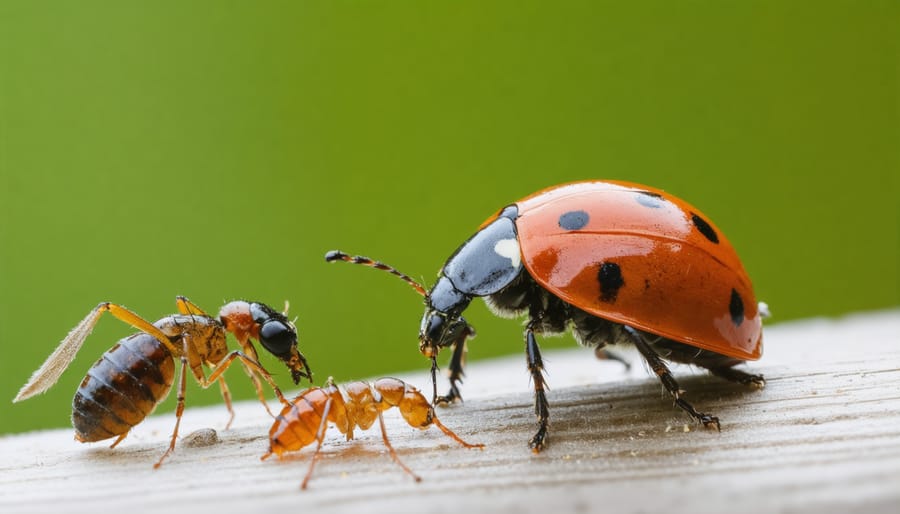
Parasitic Wasps and Flies
Parasitic wasps and flies are some of nature’s most effective pest controllers, working tirelessly to keep garden pests in check. These beneficial insects lay their eggs inside or on harmful pests like caterpillars, aphids, and beetle larvae. When the eggs hatch, the young parasites feed on the host pest, naturally reducing pest populations.
Braconid wasps, which are tiny and non-stinging, are particularly helpful in vegetable gardens. They’re especially effective against tomato hornworms – you might spot their work when you see a caterpillar covered in small white cocoons. These aren’t eggs, but rather the pupae of wasp larvae that have already done their job!
Tachinid flies, which look similar to house flies, are another valuable ally. They target squash bugs, cabbage worms, and various caterpillars. You can attract these beneficial insects by planting flowers like dill, fennel, and Queen Anne’s lace, which provide the nectar they need to survive.
Remember that these parasitic insects are incredibly sensitive to pesticides, so avoiding chemical sprays will help maintain a healthy population of these natural pest controllers in your garden.
Creating a Welcoming Environment for Beneficial Insects
Plant Selection for Insect Habitats
Creating a welcoming environment for beneficial insects starts with choosing the right plants for your garden. The key is to provide a diverse selection that offers food, shelter, and breeding grounds throughout the growing season. By incorporating natural plant partnerships, you’ll create a balanced ecosystem that naturally manages pest populations.
Flowers from the umbel family, like dill, fennel, and Queen Anne’s lace, are excellent choices as they attract predatory insects such as lacewings and parasitic wasps. Their flat, umbrella-shaped flower heads provide perfect landing pads for these helpful garden allies.
Consider including these pollinator-friendly plants in your garden:
– Yarrow: Attracts ladybugs and hover flies
– Alyssum: Provides shelter for ground beetles
– Calendula: Draws in beneficial wasps and syrphid flies
– Cosmos: Supports various predatory insects
– Herbs like oregano and thyme: Perfect for attracting pollinators
Remember to plant in clusters rather than single specimens, as this makes it easier for beneficial insects to find their preferred plants. Include plants of varying heights to create different microclimates and shelter options. Also, ensure you have something blooming from early spring through late fall to provide continuous support for your insect helpers.
Native plants are particularly valuable as they’ve evolved alongside local beneficial insects. They’re typically hardy, drought-resistant, and perfectly adapted to support your local ecosystem. When selecting plants, aim for at least three different species blooming in each season to maintain a steady population of beneficial insects throughout the year.
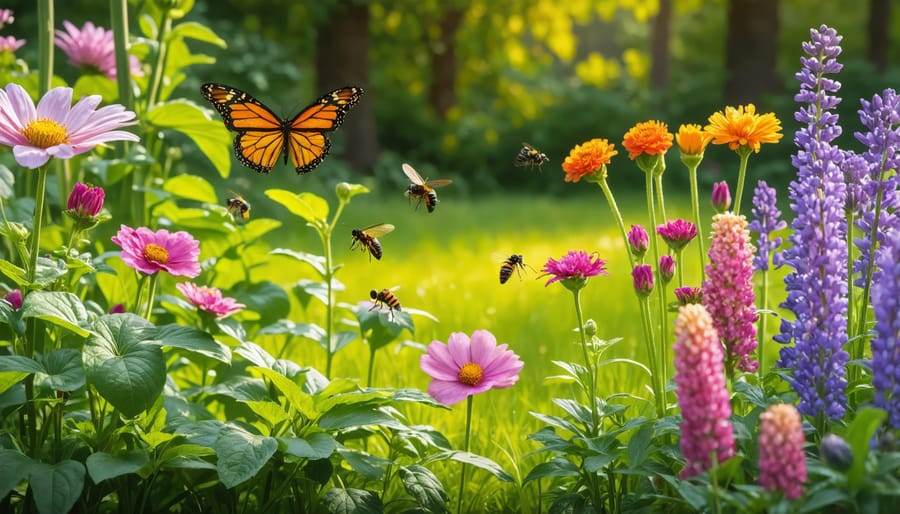
Maintaining Insect-Friendly Spaces
Creating a welcoming environment for beneficial insects is crucial for successful integrated pest management. Start by establishing diverse plantings that provide food and shelter throughout the growing season. Include flowering plants like yarrow, dill, and sweet alyssum, which attract predatory insects with their nectar and pollen.
Leave some areas of your garden slightly wild – beneficial insects love undisturbed spaces. Consider creating insect hotels using hollow stems, wood with drilled holes, and bundles of twigs. These structures provide excellent nesting sites for solitary bees and predatory wasps.
Maintain a chemical-free environment by avoiding broad-spectrum pesticides, which can harm both pest and beneficial insects alike. Instead, use targeted approaches when necessary, such as handpicking pests or using insecticidal soaps only on affected plants.
Keep your garden hydrated but not waterlogged, as many beneficial insects need access to water without drowning. A shallow dish filled with pebbles and water provides a safe drinking spot. Mulch your beds with organic materials to create hiding places for ground beetles and other helpful crawling insects.
Remember to leave some plant debris in fall and early spring – many beneficial insects overwinter in dead plant material. By maintaining these insect-friendly spaces year-round, you’ll build a sustainable ecosystem where natural pest control thrives.
Combining Methods for Effective Pest Management
Cultural Control Methods
Cultural control methods are among the most environmentally friendly approaches to pest management, working with nature rather than against it. Crop rotation is a time-tested practice that breaks pest life cycles by moving plants to different areas of your garden each season. For example, if you grew tomatoes in one bed this year, plant beans or leafy greens there next season to prevent soil-dwelling pests from establishing themselves.
Companion planting is another effective strategy that can help deter pests naturally. Marigolds planted alongside vegetables not only add beautiful color but also repel numerous garden pests. Herbs like basil near tomatoes or dill near cucumbers can enhance growth while confusing potential pests with their strong aromas.
Other cultural practices include adjusting planting times to avoid peak pest seasons, maintaining proper plant spacing for good air circulation, and selecting resistant varieties suited to your region. Keeping your garden clean by removing plant debris and weeds eliminates hiding spots for pests and their eggs.
Healthy soil is your best defense against pests, so focus on building organic matter through composting and mulching. Well-nourished plants naturally resist pest problems better than stressed ones. Remember to water at the base of plants early in the day to prevent fungal issues and create an environment less appealing to many common garden pests.
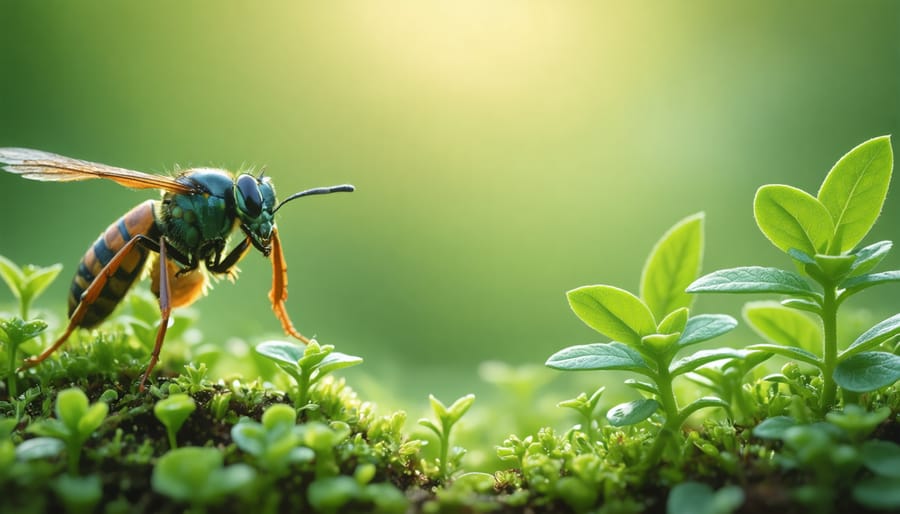
Physical Control Techniques
Physical control techniques are some of the most hands-on and satisfying methods for managing garden pests. These time-tested approaches create barriers between your plants and unwanted visitors, often without the need for chemical interventions.
Row covers and netting serve as excellent protective shields, keeping flying insects and larger pests away from your precious crops while still allowing sunlight and water to reach your plants. For crawling insects, copper tape around plant containers or raised beds can deter slugs and snails, who avoid crossing the metallic surface.
Traps are another effective physical control method. Sticky traps in yellow or blue attract and capture flying pests like aphids and whiteflies, while beer traps work wonders for slug control. For larger pests, humane catch-and-release traps can help manage rabbits or other wildlife that might venture into your garden.
Don’t overlook the power of hand-picking! While it might seem old-fashioned, physically removing larger pests like tomato hornworms or Japanese beetles can be surprisingly effective, especially in smaller gardens. A bucket of soapy water makes quick work of collected pests.
Strategic barriers like mulch, gravel, or diatomaceous earth create challenging terrain for crawling insects. These materials can also help retain moisture and improve soil quality, offering multiple benefits for your garden’s health.
Physical controls work best when combined with other IPM strategies, creating a robust defense system for your garden.
Biological Control Integration
Beneficial insects work best when they’re part of a broader pest management strategy. Think of them as team players in your garden’s defense system. For example, while ladybugs feast on aphids, they might need support from companion plants that provide them shelter and alternative food sources when pest populations are low.
To successfully integrate biological control, timing is crucial. Release beneficial insects when pest populations are just beginning to rise, not after an infestation has taken hold. This allows your garden allies to establish themselves and provide effective control. Many gardeners have found success by introducing predatory insects in the early evening when temperatures are cooler and they’re less likely to fly away.
Combine biological control with cultural practices for the best results. Maintain healthy soil, practice crop rotation, and use physical barriers like row covers when necessary. These methods work together to create an environment where beneficial insects can thrive while making life difficult for pest species.
Remember to avoid broad-spectrum pesticides, even organic ones, as they can harm your beneficial insects. Instead, use selective treatments that target specific pests when absolutely necessary. Creating diverse plantings with flowers, herbs, and vegetables provides natural habitat and food sources for beneficial insects throughout the growing season.
By taking this integrated approach, you’ll build a resilient garden ecosystem where beneficial insects can establish permanent populations and provide long-term pest control naturally.
Monitoring and Maintaining Balance
Success in integrated pest management relies heavily on regular monitoring pest populations and maintaining a delicate balance in your garden ecosystem. Think of yourself as a garden detective, making weekly observations of both pest and beneficial insect activity. Keep a simple garden journal to track what you see – noting changes in plant health, insect populations, and weather patterns can reveal valuable patterns over time.
Walk through your garden during different times of day, as some pests are more active in the morning while others prefer dusk. Look under leaves, check stem joints, and observe any signs of damage. Remember, seeing a few insects isn’t necessarily cause for alarm – it’s natural and even healthy to have some pest presence in your garden.
Set action thresholds for different plants and pests. For example, you might tolerate a few aphids on your roses but take action when they start affecting new growth. Use sticky traps or simple visual inspections to gauge pest levels, and don’t forget to count the good guys too! A healthy population of ladybugs or parasitic wasps often indicates your garden’s natural defenses are working well.
Maintain plant diversity to support beneficial insects throughout the season. Include flowering plants that provide nectar and pollen, creating a year-round habitat for your garden allies. Regular pruning, proper spacing, and good air circulation help prevent pest problems before they start.
Remember, the goal isn’t to eliminate all pests but to create a balanced ecosystem where beneficial insects can help keep pest populations in check naturally.
As we’ve explored throughout this article, integrated pest management using beneficial insects offers a sustainable, effective approach to garden care that works in harmony with nature. By creating welcoming environments for helpful creatures like ladybugs, praying mantises, and parasitic wasps, you’re not just controlling pests – you’re building a thriving ecosystem in your garden.
Remember that success with beneficial insects doesn’t happen overnight. Start small by incorporating a few native flowering plants and reducing chemical pesticide use. As you become more comfortable with this approach, gradually expand your beneficial insect habitat and observe the positive changes in your garden’s health.
The key is maintaining balance and patience. While you might still see some pest damage, remember that a few holes in leaves are a small price to pay for a chemical-free, wildlife-friendly garden. Keep notes about what works in your space, and don’t be afraid to adjust your strategy as needed.
Whether you’re a seasoned gardener or just starting out, implementing these natural pest control methods will help create a more resilient and sustainable garden. Your efforts will not only benefit your plants but also contribute to the broader environmental health of your community.
Take that first step today – plant some beneficial-attracting flowers, create a water source, or simply commit to reducing chemical use. Your garden’s beneficial insects are ready to work for you!

